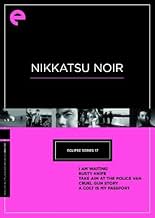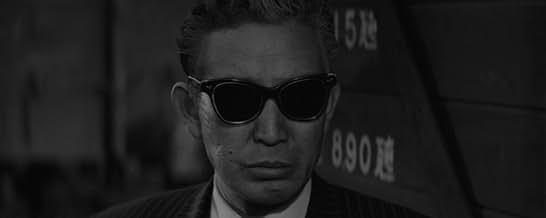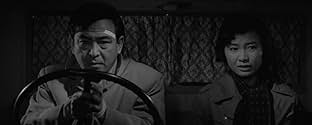IMDb-BEWERTUNG
6,6/10
1444
IHRE BEWERTUNG
Füge eine Handlung in deiner Sprache hinzuA prison truck is assaulted and the two convicts inside are murdered. The prison guard on duty gets suspended for negligence and takes it upon himself to track down the killers.A prison truck is assaulted and the two convicts inside are murdered. The prison guard on duty gets suspended for negligence and takes it upon himself to track down the killers.A prison truck is assaulted and the two convicts inside are murdered. The prison guard on duty gets suspended for negligence and takes it upon himself to track down the killers.
- Regie
- Drehbuch
- Hauptbesetzung
Empfohlene Bewertungen
A 1960 police actioner from writer/director Seijin Suzuki (Branded to Kill/Tokyo Drifter) about a disgraced prison guard, Michitaro Mizushima, who loses some of his charges during a shootout during a nighttime transfer. Taking the law into his own hands but also at some point in the story cops are brought in, Mizushima tracks down the players behind the act siding up to the moll of one of the crooks in the hopes of getting back some dignity he suffered from the escape. As per Noir Alley's host Eddie Muller, the film was a revelation to Japanese audiences, especially the younger sect, which embraced the film embarrassing the honchos at the film studio but now 64 years after the fact the film is fine but ultimately safe when a lot of the gunfights which may've lit a fire under the viewing public butts now feel like so much uncontrolled chaos but the throughline of the plot is solid enough though.
Twisty detective flick from the director of Branded to Kill. After the police van of which he was in charge is ambushed by a sniper, prison guard Michitaro Mizushima (the star of the earlier Suzuki film Underworld Beauty) is suspended from his job. Upset over his failure to protect those under his charge, Mizushima conducts his own investigation. This is an extremely convoluted mystery - a fact to which the film cops. Suzuki's master direction keeps it moving. The opening and closing sequences in particular are brilliant. I just wish I knew what the Hell was going on! I was very tired while watching it, I should say.
An exceptionally well-shot if bitterly average and utterly bewildering mystery, Take Aim at the Police Van marks the very early days for Seijun Suzuki, far less abstract than what I've heard about his more well-known works. He's shooting to a formula but delivering where it matters, be it the woman killed by an arrow to the boob or the faceless gunman who lovingly strokes his rifle's stock before sticking his bubblegum atop its scope. It's a film I wish was slightly more cohesive (and less jazzy) than it is but Police Van benefits from the endless swagger of its lead and fun filmmaking flourishes to stop it from being a frustrating or bad time. A testament to how artists pumping out quickie exploitation movies can often work in truths about their times that prestige filmmakers can't.
Take Aim at the Police Van is action-packed, fast-moving Japanese Noir. Perhaps though, it's a little too fast moving. And unfortunately employs some rather erratic editing.
The story itself has all the makings of a good noir-ish detective murder mystery. Daijirô Tamon (Michitarô Mizushima) is a prison guard who has convicts murdered during a prison transfer. Tamon decides to hunt down those responsible. He quickly stumbles upon an "agency" that supplies young women as "showgirls" and "masseuses". There is no need to read between the lines or even get metaphorical as the fact they are being used as call-girls is blatantly evident. However, Tamon begins to have feelings for the agency's madam, Yûko (Misako Watanabe).
Directed by Seijun Suzuki, Take Aim at the Police Van builds up a good mystery and adds in a number of chases and shooting sequences. Yet the speed of the story and the choppiness of the editing truly shows that this was simply another movie quickly being fed through the Nikkatsu Studios machine. As swiftly Tamon decides to solve the case, the source of all the woe is discovered (also, such identity is not a shock), and the credits roll.
Take Aim at the Police Van is faster than service at a ramen house. But also quite tasty.
The story itself has all the makings of a good noir-ish detective murder mystery. Daijirô Tamon (Michitarô Mizushima) is a prison guard who has convicts murdered during a prison transfer. Tamon decides to hunt down those responsible. He quickly stumbles upon an "agency" that supplies young women as "showgirls" and "masseuses". There is no need to read between the lines or even get metaphorical as the fact they are being used as call-girls is blatantly evident. However, Tamon begins to have feelings for the agency's madam, Yûko (Misako Watanabe).
Directed by Seijun Suzuki, Take Aim at the Police Van builds up a good mystery and adds in a number of chases and shooting sequences. Yet the speed of the story and the choppiness of the editing truly shows that this was simply another movie quickly being fed through the Nikkatsu Studios machine. As swiftly Tamon decides to solve the case, the source of all the woe is discovered (also, such identity is not a shock), and the credits roll.
Take Aim at the Police Van is faster than service at a ramen house. But also quite tasty.
(1960) Take Aim At The Police Van/ 'Jûsangô taihisen' yori: Sono gosôsha o nerae
(In Japanese with English subtitles)
CRIME DRAMA/ MYSTERY/ ACTION
The set up regards a prison guard, Daijirô Tamon (Michitarô Mizushima) getting suspended for six months as a result of failing to protect two prisoners. He then goes on an odyssey to find out why. First he would interview another former inmate prisoner who was also there by the name of Gorô Kashima (Shôichi Ozawa), as Tamon realizes he scribbled something onto the window on the bus they both riding on before the other two inmates were executed. And he tries to follow him after seeing the name Aki written on a piece of paper. Leading him to uncover two objectives which is to find out who was that lady he had seen on the fateful night during the bus ride and the identity of Aki who we find out is actually Akiba.
Despite it's short running time of less than a hour and a half, this was quite boring until it got to the very end with the gun shootings to be quite relative.
The set up regards a prison guard, Daijirô Tamon (Michitarô Mizushima) getting suspended for six months as a result of failing to protect two prisoners. He then goes on an odyssey to find out why. First he would interview another former inmate prisoner who was also there by the name of Gorô Kashima (Shôichi Ozawa), as Tamon realizes he scribbled something onto the window on the bus they both riding on before the other two inmates were executed. And he tries to follow him after seeing the name Aki written on a piece of paper. Leading him to uncover two objectives which is to find out who was that lady he had seen on the fateful night during the bus ride and the identity of Aki who we find out is actually Akiba.
Despite it's short running time of less than a hour and a half, this was quite boring until it got to the very end with the gun shootings to be quite relative.
Wusstest du schon
- WissenswertesA trail of gasoline poured on the ground as depicted here, would burn at only about three miles per hour, or about the pace of a brisk walk. This velocity was tested on Trail Blazers (2007).
- PatzerIn the opening scenes, the prisoner's handcuffs are so loose that he could easily slip his hand through.
- VerbindungenFeatured in Best in Action: 1960 (2018)
Top-Auswahl
Melde dich zum Bewerten an und greife auf die Watchlist für personalisierte Empfehlungen zu.
Details
- Erscheinungsdatum
- Herkunftsland
- Sprache
- Auch bekannt als
- Take Aim at the Police Van
- Produktionsfirma
- Weitere beteiligte Unternehmen bei IMDbPro anzeigen
- Laufzeit1 Stunde 19 Minuten
- Farbe
- Seitenverhältnis
- 2.35 : 1
Zu dieser Seite beitragen
Bearbeitung vorschlagen oder fehlenden Inhalt hinzufügen

Oberste Lücke
What is the Spanish language plot outline for 'Jûsangô taihisen' yori: Sono gosôsha o nerae (1960)?
Antwort


























